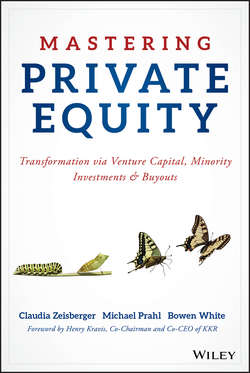Читать книгу Mastering Private Equity - Prahl Michael - Страница 6
На сайте Литреса книга снята с продажи.
HOW TO USE THIS BOOK
ОглавлениеThis book was written with a professional audience in mind and carefully structured to accommodate both graduate students and experienced professionals. It makes a solid attempt at reflecting on its central themes without judgment, by relating the facts and ensuring that readers are well prepared to participate in an intelligent discussion about the pros and cons of private equity (PE).
Used together with the case book Private Equity in Action – Case Studies from Developed and Emerging Markets, which complements the text, this book brings the learning points to life and offers readers a ringside seat to the day-to-day challenges facing partners in PE and venture funds.
● For novices to the field of PE, our book provides clear insights into the workings of the industry. While the book assumes a sound understanding of basic finance, accounting techniques and risk–return concepts, it offers links to literature and research to ensure clarity for those rusty in the theoretical concepts behind today's financial markets.
● Graduate and postgraduate students will find the book an invaluable companion for their PE, venture capital and entrepreneurship courses; it will allow them to connect the dots and ensure that an understanding of the dynamics in the industry is maintained as they explore the respective chapters in greater detail.
● For seasoned financial professionals, the book includes guest comments from industry experts and links to advanced literature that provides a nuanced view of the industry and will allow them to engage with other professionals, be they lawyers, bankers, consultants or partners of PE firms, in a meaningful way.
Ensuring that our readers develop a sound understanding of PE before diving into more controversial aspects of the industry was a clear goal from the outset; it defined the flow and the logic of the chapters. The book's structure allows the expert reader to use the book as a quick reference with easily retrievable highlights of the best practices employed in the industry; it also allows observers of the industry and students to work through the topics step by step and take advantage of the many resources and cross-references to other finance topics.
Overall the chapters are grouped into five sections:
SECTION I offers a high-level introduction to PE to ensure that we speak the same language and use appropriate industry terms and definitions throughout the book. It puts venture capital, growth equity and leveraged buyouts into context and describes several alternative PE investment strategies such as distressed investing and real estate.
SECTION II looks in greater detail at PE investment processes, starting with deal sourcing, due diligence and target valuation before exploring deal pricing considerations and the actual structuring of PE deals. It also includes a thorough coverage of transaction documentation.
SECTION III asks: What do PE and venture funds do with their portfolio companies during the holding period? How will they transform these businesses and prepare them for exit?
SECTION IV describes the key dynamics involved in raising a PE fund. We step into the shoes of global institutional investors in PE to examine their demands with regard to reporting and portfolio customization.
SECTION V builds on the understanding gained in the previous chapters and takes a closer look at recent developments in the industry, from direct and co-investment programs to the fast-growing secondaries markets and the recent rise of listed PE funds. In the closing chapter the authors comment on the industry's development and explore key themes that will shape private equity and venture capital in the years ahead.
Additional material to complement this book and connect it to the case book Private Equity in Action – Case Studies from Developed and Emerging Markets can be found on the companion website:
www.masteringprivateequity.com
